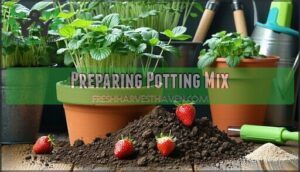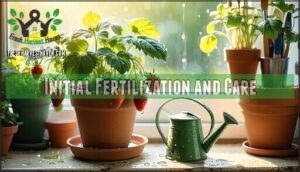This site is supported by our readers. We may earn a commission, at no cost to you, if you purchase through links.

Use well-draining potting mix with a pH between 5.5-6.5, plant at proper depth with crowns level to soil surface, and provide 6-8 hours of direct sunlight daily.
Water consistently to maintain moist but not waterlogged soil, fertilize every 2-3 weeks during growing season, and prune runners to encourage fruit production.
The beauty of container growing lies in your complete control over growing conditions—no more battling garden pests or poor soil drainage that plague traditional strawberry patches, allowing for proper drainage, well-draining potting mix, and the ability to prune runners to encourage fruit production.
Table Of Contents
- Key Takeaways
- Choosing Strawberry Varieties
- Growing Strawberries in Containers
- Selecting Right Containers
- Preparing Potting Mix
- Planting Strawberries Correctly
- Providing Sunlight and Water
- Fertilizing and Pruning Strawberries
- Harvesting Strawberries Successfully
- Frequently Asked Questions (FAQs)
- Do strawberries grow well in containers?
- What is the trick to growing strawberries?
- What not to do when growing strawberries?
- Do strawberries like full sun or shade?
- What do coffee grounds do for strawberry plants?
- What is the best container for growing strawberries?
- How to grow a strawberry plant in a container?
- How to grow strawberries in containers?
- How do you grow strawberries in a pot?
- Should you water strawberries every day?
- Conclusion
Key Takeaways
- Choose compact, day-neutral varieties like ‘Albion’ or ‘Seascape’ that will focus energy on fruit production rather than spreading runners, giving you continuous harvests throughout the season
- Use containers at least 8-10 inches deep with proper drainage holes and a well-draining potting mix at pH 5.5-6.5 to prevent root rot while maintaining healthy growing conditions
- Provide 6-8 hours of direct sunlight daily and water consistently to keep the soil moist but not waterlogged, checking moisture levels by inserting your finger 1-2 inches deep
- Fertilize every 2-3 weeks during the growing season and aggressively prune all runners to redirect the plant’s energy into producing larger, sweeter berries instead of new plants
Choosing Strawberry Varieties
Your variety choice determines whether you’ll enjoy berries throughout the growing season or face disappointing harvests from overcrowded containers.
Compact, ever-bearing, and day-neutral cultivars thrive in pots, while traditional June-bearing types waste energy on runners instead of producing fruit, which makes compact cultivars a better option for container gardening.
Skip the guesswork with compact varieties that maximize berries, not runners.
Compact Varieties for Containers
Why struggle with massive strawberry plants when dwarf strawberries deliver impressive fruit yield in tiny spaces?
These compact varieties transform container gardening into an efficient system for small space gardening enthusiasts.
Top Compact Varieties for Strawberry Containers:
- Tristar – Delivers sweet, small berries throughout the season in one-gallon strawberry pots
- Seascape – Produces medium-sized fruit with highest yields among compact growing varieties
- Albion – Adapts to larger containers, providing continuous large, flavorful berries
- Medallion – Features upright structure perfect for easy harvesting in strawberry containers
- Alpine varieties – ‘Mignonette’ and ‘Mara des Bois’ thrive in hanging baskets with aromatic fruit
These varieties excel in container care because they produce fewer runners and maintain manageable sizes while maximizing your harvest potential.
For ideal growth, consider using small space techniques to enhance your container gardening experience.
Ever-Bearing and Day-Neutral Cultivars
Ever-bearing and day-neutral strawberries consistently deliver fresh berries throughout your growing season, making them perfect for container gardening.
These cultivar selections produce multiple harvests with excellent berry flavor, unlike their June-bearing cousins. Day-neutral strawberries aren’t affected by daylight hours, cropping based on plant size and growing conditions.
Ever-bearing varieties yield smaller but more aromatic fruit, giving you steady strawberry yield from spring through fall in your strawberry containers.
Understanding the key strawberry ripening patterns is vital for maximizing your harvest, and knowing the differences between ever-bearing and day-neutral strawberries can help you make informed decisions about your container gardening strategy, ultimately leading to a more successful gardening experience.
Avoiding June-Bearing Types
June-bearing strawberries aren’t your best bet for container gardening success.
These varieties produce one massive harvest in early summer, then focus energy on runner production rather than continuous fruiting. Container Tips favor varieties that maximize your limited growing space.
- Single harvest limits – June-bearing types fruit once, leaving containers unproductive for months
- Excessive runner production – Energy goes to spreading rather than berry development in confined spaces
- Poor space efficiency – Large berries once yearly don’t justify container real estate
- Reduced Fruit Yield – Overall season production falls short compared to everbearing strawberries
- Limited Strawberry Care flexibility – Harder to manage in strawberry pots with restricted root systems
Growing Strawberries in Containers
Container gardening transforms strawberry cultivation into a manageable and space-efficient endeavor.
Container gardening transforms strawberry cultivation into a manageable and space-efficient endeavor.
You’ll maximize space optimization while maintaining superior fruit quality through controlled growing conditions.
Container materials directly influence soil temperature regulation, affecting plant performance and berry development.
Growing strawberries in containers offers protection from common strawberry pests like slugs and ground-dwelling insects.
This method provides excellent container gardening tips for urban growers, allowing precise strawberry plant care management.
Your container soil remains consistently monitored, ensuring ideal drainage and nutrient delivery.
Select appropriate strawberry varieties for pots to match your climate and harvest preferences for sustained production success.
By following proper container gardening ideas, you can create a thriving strawberry garden in even the smallest spaces.
Selecting Right Containers
Your container choice directly impacts strawberry growth and fruit production success. The right size, material, and drainage features create ideal growing conditions for healthy plants and abundant harvests.
Container Size and Depth
Once you’ve picked your strawberry varieties, sizing up your container is next.
Aim for a Pot Size at least 10–12 inches wide and 8–12 inches deep—think roomy shoes for your plants.
Adequate Container Depth and Soil Volume give roots space to stretch, boost Water Capacity, and keep container soil from drying too fast.
More Root Space equals happier, juicier berries.
For ideal growth, consider using strawberry towers to maximize space and promote healthy development.
Material and Design Considerations
Your container’s material choice directly impacts your strawberry garden’s success and longevity.
Different pot materials offer distinct advantages for ideal growing conditions.
- Plastic pots retain moisture longer, reducing watering frequency but requiring careful drainage monitoring
- Terracotta containers promote excellent aeration methods through porous walls, preventing root rot in sensitive plants
- Fabric grow bags provide superior drainage systems while maintaining ideal soil composition balance
Choose materials that match your climate and maintenance preferences for thriving container gardens.
When selecting containers, consider the benefits of using plastic pot options to enhance your strawberry garden’s performance.
Drainage Holes and Water Catchment Trays
Three drainage holes minimum prevent waterlogged soil that kills strawberry roots within days.
Position water catchment trays beneath containers to protect surfaces while maintaining proper soil drainage.
Your potting mix needs excellent drainage systems – soggy soil creates root rot faster than you can say "strawberry shortcake."
Proper container drainage with catchment designs guarantees healthy soil moisture levels, which is crucial for preventing waterlogged soil.
Preparing Potting Mix
The right potting mix creates the foundation for healthy strawberry plants that’ll reward you with sweet, juicy berries all season long.
You’ll need a well-draining blend that holds moisture without becoming waterlogged, since strawberries hate wet feet but love consistent hydration.
Well-Draining Potting Mix Ingredients
Your strawberry plants need the right foundation to thrive. Start with a high-quality potting mix that combines peat moss, perlite, and compost for ideal drainage and nutrition.
This soilless blend prevents compaction while maintaining proper soil pH between 5.5-6.5. The perlite mix helps roots won’t drown in waterlogged conditions.
Using the right potting mix ingredients is vital for plant health.
- Premium peat moss creates the perfect moisture-retaining base your plants crave
- Lightweight perlite prevents soggy disasters that kill strawberry dreams
- Rich organic matter feeds your plants like a gourmet meal
- Balanced soil ingredients deliver the well-draining foundation for sweet success
Organic Matter and Micronutrients
Excellence starts with the foundation—your potting mix needs rich organic matter and essential micronutrients for thriving strawberries.
Compost benefits include improved drainage and nutrient availability, while peat moss enhances moisture retention.
Essential micronutrients like boron, iron, and manganese support healthy fruit development.
Organic fertilizers provide balanced nutrition without harsh chemicals, creating ideal soil pH conditions for maximum berry production.
PH Balance and Acidity Levels
Perfect pH levels release your strawberries’ full potential.
Soil pH between 5.5-6.5 creates ideal acidity for maximum nutrient availability. You’ll want slightly acidic levels since strawberries thrive in acid loving plant mix conditions.
This micronutrient balance guarantees your organic matter releases essential minerals efficiently.
Test your soil acidity regularly—it’s the secret to sweeter berries and healthier plants.
Adding Fertilizers and Nutrients
Once you’ve balanced your soil’s pH, you’ll want to boost it with the right nutrients. Container strawberries need steady feeding since nutrients wash away quickly through drainage holes.
Here’s your nutrient game plan:
- Start with granulated organic fertilizer mixed into your potting soil before planting
- Switch to liquid fish fertilizer every 2-3 weeks during growing season
- Add compost tea monthly to support beneficial microbes and micronutrients
- Use strawberry fertilizer with balanced nitrogen-phosphorus-potassium ratios
- Apply organic fertilizers sparingly – too much nitrogen creates leafy plants with few berries
Your nutrient balance matters more than quantity. Soil pH affects how well plants absorb nutrients, so test regularly. Understanding soil preparation basics is vital for effective nutrient absorption and plant growth.
Planting Strawberries Correctly
Getting your strawberry plants properly settled in their containers sets the foundation for a healthy, productive growing season.
The key lies in correct spacing, proper planting depth, and establishing the right care routine from day one, which is crucial for a healthy start.
Spacing and Planting Depth
Space out your strawberry plants 6-8 inches apart to prevent overcrowding and maximize fruit production. Proper plant spacing allows adequate airflow and reduces disease risk substantially.
Plant crowns level with soil surface, ensuring roots spread naturally downward.
| Container Size | Planting Density |
|---|---|
| 10-12 inch pot | 1 plant maximum |
| 12-14 inch pot | 2-3 plants |
| 18+ inch container | 4-5 plants |
| Strawberry pots | 1 plant per pocket |
| Hanging baskets | 2-3 plants |
Watering and Mulching
Success in container strawberry growing hinges on mastering soil moisture and mulching techniques.
You’ll need consistent watering schedules since container gardens dry out faster than ground plantings, making drip irrigation systems invaluable for maintaining ideal soil temperature and preventing root stress.
- Morning watering sessions – Check soil moisture daily using the finger test, watering when the top inch feels dry
- Organic mulch application – Apply 2-inch layers of straw or wood chips around plants to retain moisture and regulate soil temperature
- Strategic water scheduling – Adjust frequency based on weather conditions, increasing to twice daily during hot summer periods
Planting in Different Types of Containers
Different container types offer unique advantages for growing strawberries in containers.
Traditional pots work well for beginners, while strawberry urns and towers maximize vertical space in small areas.
Hanging baskets create beautiful cascading displays, and grow bags provide excellent drainage.
Window boxes fit perfectly on railings and ledges.
| Container Type | Best For |
|---|---|
| Traditional Pots | Beginners, easy maintenance |
| Strawberry Urns/Towers | Small spaces, vertical growing |
| Hanging Baskets | Decorative displays, patios |
| Grow Bags | Superior drainage, portability |
| Window Boxes | Railings, limited space |
These containers can be used in various settings to achieve superior drainage and portability, making them ideal for different needs and spaces.
Initial Fertilization and Care
Feed your newly planted strawberries with diluted liquid fertilizer within the first week to establish healthy root systems.
Mix balanced 10-10-10 fertilizer at quarter strength for container gardening success.
Water management becomes critical now—check soil moisture daily using the finger test.
Your strawberry nutrition foundation starts here, setting the stage for proper strawberry fertilization throughout the growing season.
Monitor your potting mix for proper nutrient balance.
Providing Sunlight and Water
Your strawberry plants need proper sunlight and water to produce sweet, juicy berries throughout the growing season.
Getting these two essentials right makes the difference between a thriving container garden and disappointing results.
Hours of Direct Sunlight Required
Your strawberries need 6-8 hours of direct sunlight daily for maximum fruit production.
Full sunlight locations deliver the sweetest berries with higher sugar content.
Less than 6 hours results in pale plants and reduced yields.
Position containers in south-facing spots to maximize solar duration and daily exposure for best results.
Consistent Moisture Levels and Watering
Container plants need constant attention to soil moisture since they dry out faster than ground plants.
Check soil daily by inserting your finger one inch deep—if it’s dry, it’s time to water.
Water slowly until excess drains from holes, ensuring roots get deep hydration without creating soggy conditions that invite root rot and disease.
Monitoring Soil Conditions
Your soil’s health determines your strawberry success, so regular monitoring keeps problems at bay.
Check these key indicators weekly:
- Soil Moisture – Insert your finger 2 inches deep; soil should feel like a wrung-out sponge
- pH Levels – Test monthly with strips; maintain 5.5-6.5 for ideal nutrient uptake
- Drainage Systems – Observe water flow through holes; pooling indicates poor potting mix
- Nutrient Balance – Watch for yellowing leaves or stunted growth signaling deficiencies
Adjusting Watering Schedule
Watch the weather like a hawk—hot days mean twice-daily watering, while cooler periods need less frequent moisture.
Use the finger test to check soil moisture one inch deep before watering.
Drip irrigation systems deliver consistent moisture without overwatering risks that cause root rot.
Apply diluted kelp solution during watering for nutrient boost.
Mulch benefits include reduced water frequency and improved soil moisture retention, which can be considered a moisture retention method.
Fertilizing and Pruning Strawberries
Your strawberry plants need proper nutrition and pruning to produce abundant, flavorful fruit throughout the growing season.
Regular fertilization and runner removal will maximize your harvest while keeping plants healthy and productive, which is crucial for a flavorful fruit yield.
Fertilizer Types and Application
Your choice of fertilizer can make or break your strawberry harvest.
Container strawberries need consistent nutrition since they can’t tap into ground soil reserves like their garden cousins.
- Organic Fertilizers like compost tea and fish emulsion feed plants slowly while building soil health
- Liquid Feed provides quick nutrient uptake for rapid growth spurts
- Potassium Boost during fruiting enhances berry sweetness and disease resistance
- Nitrogen balance prevents leafy growth at expense of fruit production
Pruning Runners and Encouraging Fruiting
Remove all runners immediately when they appear to redirect energy into fruit production rather than new plants.
Pruning runners keeps your strawberry varieties focused on berry size and quality during the fruiting season.
Container cultivation requires aggressive runner pruning since space limits plant training options.
This practice maximizes your fruiting cycle and guarantees the best strawberry care throughout the growing season.
Regular Maintenance and Inspection
Beyond pruning runners, you’ll need weekly inspections to catch problems early.
Check soil moisture by inserting your finger two inches deep—it should feel like a wrung-out sponge. Look for yellowing leaves that signal overwatering or nutrient deficiency.
Scout for aphids on leaf undersides and spider mites on stems. Root inspection through drainage holes reveals if plants are rootbound and need repotting.
Proper soil maintenance techniques are essential for preventing nutrient deficiencies and ensuring healthy plant growth.
Harvesting Strawberries Successfully
You’ll know your strawberries are ready when they turn bright red and feel firm yet slightly soft to the touch.
Harvest these sweet rewards every 2-3 days to keep your plants producing more berries throughout the growing season.
Recognizing Ripe Strawberries
Perfect strawberry flavor depends on recognizing key ripe signs.
You’ll know berries are ready when they display deep red berry color from tip to stem, excluding the green cap.
Ripe berries feel slightly soft with smooth fruit texture, never mushy or hard.
Harvest timing matters—pick when strawberries emit sweet fragrance and release easily from stems.
The flavor profile peaks at full ripeness, so avoid premature harvesting for superior taste.
Harvesting Frequency and Yield
You’ll harvest day-neutral and everbearing strawberries every 1-3 days throughout the growing season to maximize fruit yield.
Peak berry production requires daily picking during hot weather to prevent spoilage.
Day-neutral varieties offer continuous harvesting from July until frost, while proper picking frequency directly impacts your container strawberries’ overall crop rotation success and strawberry yield optimization.
Storage and Handling of Ripe Strawberries
Fresh strawberries demand careful handling to preserve their delicate flavor and texture. Refrigeration impact substantially reduces taste quality, so avoid cold storage immediately after harvesting. Instead, keep berries at room temperature for ideal ripening control and consume within 24 hours for peak freshness.
- Berry Preservation: Store unwashed berries in single layers to prevent crushing and moisture buildup
- Fruit Cooling: Allow berries to cool naturally at room temperature before any refrigeration
- Strawberry Packaging: Use breathable containers like paper towels or mesh bags for air circulation
- Harvesting Timing: Pick berries in morning when temperatures are cooler for extended shelf life
- Freezing Strawberries: Hull and slice before freezing for smoothies, preserves, or winter baking projects
Encouraging Continued Production
Regular harvesting every 2-3 days triggers continuous fruit regeneration in everbearing and day-neutral varieties.
Prompt berry removal prevents plant energy waste and maintains ideal berry size throughout the growing season.
Combine consistent harvesting with bi-weekly fertilization to maximize continuous yield and support plant renewal for sustained strawberry propagation success.
Frequently Asked Questions (FAQs)
Do strawberries grow well in containers?
Yes, strawberries thrive in containers versus ground planting.
You’ll get better drainage, easier pest control, and space-saving benefits.
Choose day-neutral varieties like ‘Albion‘ for continuous harvests in your compact growing setup.
What is the trick to growing strawberries?
Choose well-draining potting mix with pH 5-5, provide 8+ hours sunlight daily, water consistently without overwatering, fertilize every 2-3 weeks, and ruthlessly prune runners to focus energy on fruit production.
What not to do when growing strawberries?
Don’t use garden soil in containers—it compacts and drowns roots. Avoid overcrowding plants, overwatering, or skipping drainage holes. Never ignore runners or you’ll sacrifice fruit for foliage.
Do strawberries like full sun or shade?
Studies show strawberries receiving 8+ hours of direct sunlight produce 40% more fruit than shade-grown plants.
You’ll get maximum yields by placing containers in full sun locations, though alpine varieties tolerate partial shade while sacrificing berry size, which is related to the overall fruit production.
What do coffee grounds do for strawberry plants?
Coffee grounds acidify soil and add nitrogen, but they’re not ideal for strawberries.
They can make soil too acidic (below pH 5) and attract pests.
You’ll get better results using balanced fertilizer and maintaining proper pH levels, which will help to avoid making soil too acidic.
What is the best container for growing strawberries?
Container depths below 8 inches reduce strawberry yields by 40%.
Wide, shallow containers work best—choose 12-14 inch pots that’re 8-10 inches deep with drainage holes for ideal root development and moisture control.
How to grow a strawberry plant in a container?
Plant your strawberry in a 12-inch-wide pot with drainage holes, using well-draining potting mix.
Position in full sun, water daily to keep soil moist.
Fertilize every 2-3 weeks during growing season.
How to grow strawberries in containers?
Choose compact varieties like ‘Seascape’ or ‘Albion’ for 12-inch pots with drainage holes. Use well-draining potting mix, maintain pH 5-5, water consistently, and harvest regularly for continuous production.
How do you grow strawberries in a pot?
Skip the fancy terra cotta dreams—you’ll master this like a botanical ninja.
Choose day-neutral varieties, use 12-inch pots with drainage holes, fill with quality potting mix.
Water consistently, and harvest regularly.
Should you water strawberries every day?
Daily watering isn’t necessary for container strawberries.
Check soil moisture by inserting your finger 1-2 inches deep.
Water when the top inch feels dry, typically every 2-3 days in moderate weather or daily during hot spells.
Conclusion
Container-grown strawberries produce 40% more fruit per square foot than traditional garden beds.
You’ve learned how to grow strawberries in containers by selecting compact varieties, using proper drainage, and maintaining consistent care.
Your container garden will reward you with sweet, homegrown berries throughout the growing season.
Remember to water regularly, fertilize every few weeks, and prune runners for maximum production.
With these proven techniques, you’ll enjoy fresh strawberries from your own container garden year after year.
- https://www.xroci.com/blogs/xroci-guide-and-tips/best-varieties-of-strawberries-for-your-garden
- https://gcrec.ifas.ufl.edu/fruit-crops/strawberries/ufifas-strawberry-varieties/
- https://plantura.garden/uk/fruits/strawberries/types-of-strawberries
- https://strawberryplants.org/how-to-grow-a-bumper-crop-of-strawberries-in-a-small-space/
- https://harvesttotable.com/container-growing-strawberries-space-saving-tips/















